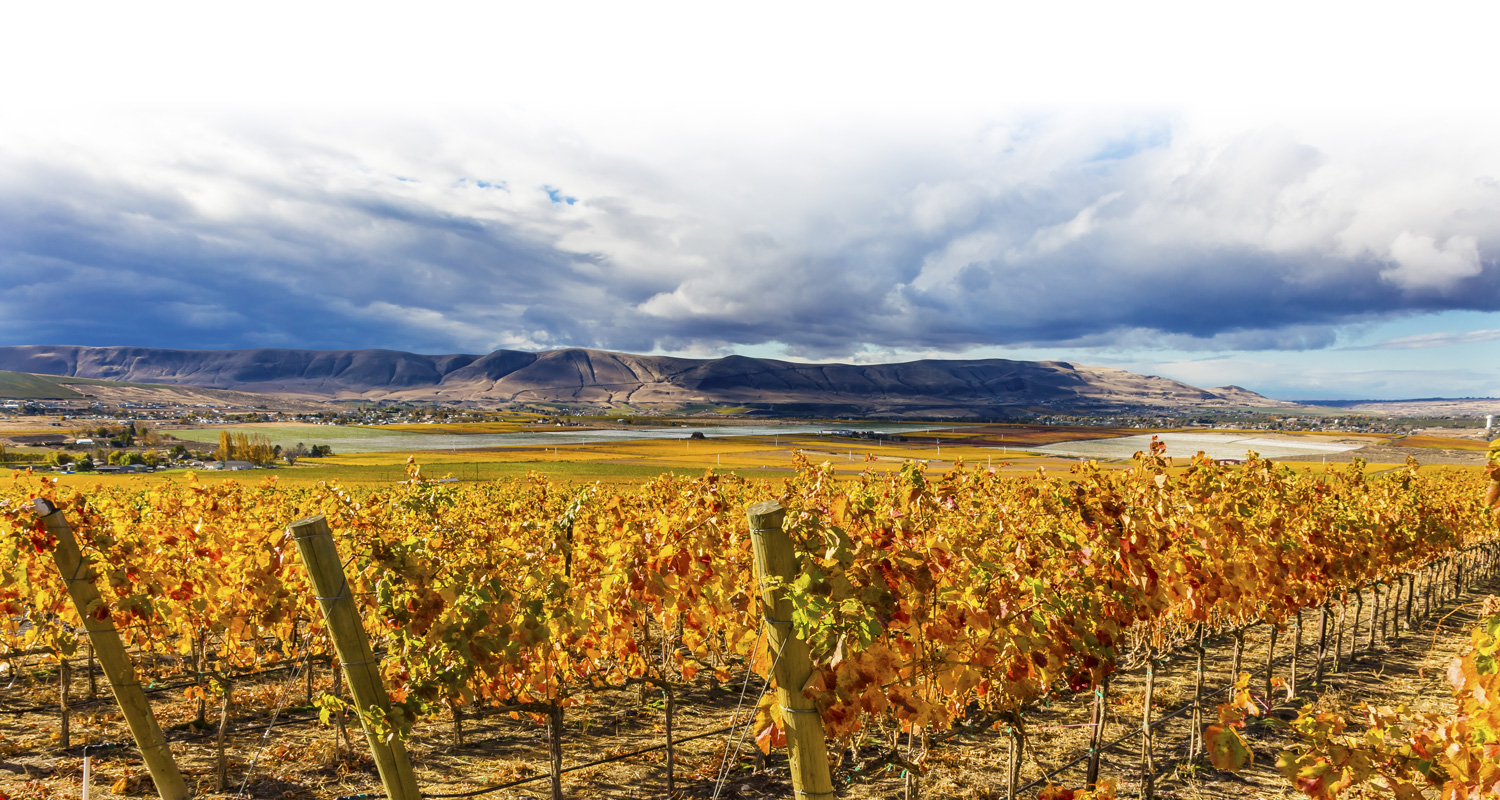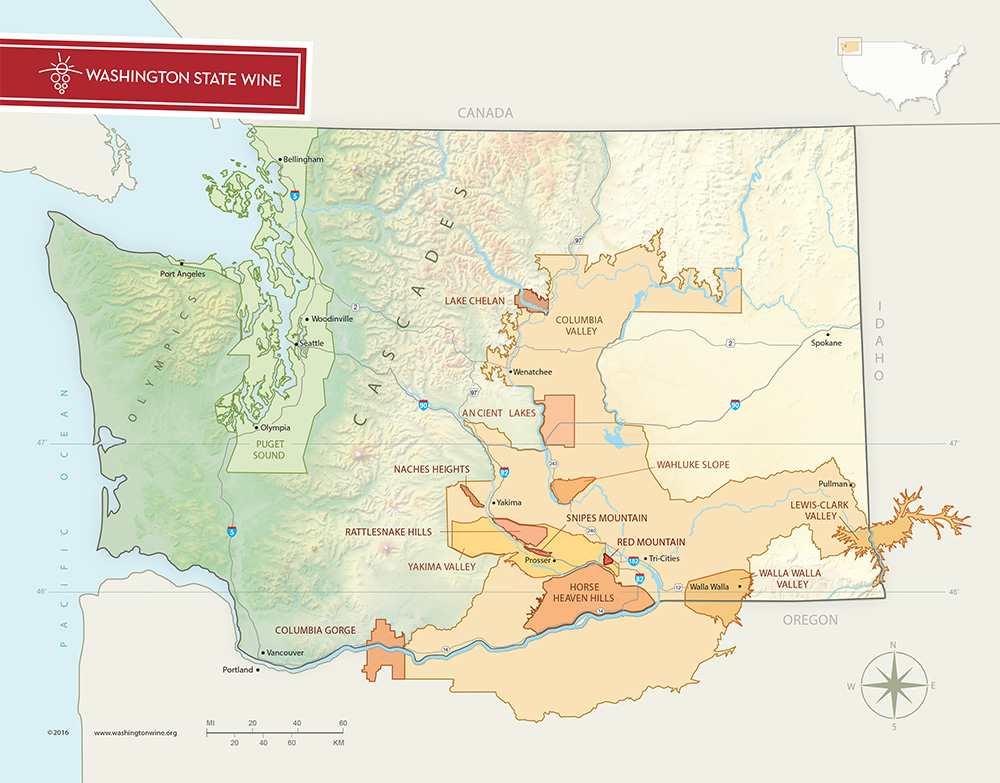Washington State:
One of the world’s most dynamic wine regions
It’s the second largest wine region in the U.S. with more than 50,000 acres of grape vines and more than 900 wineries
EDITOR’S NOTE: Information contained in this article was obtained from the Washington State Wine Commission’s website: www.washingtonwine.org. The Commission’s website is a “MUST VISIT” for anyone who wants to learn about the Washington State wine industry, which is now one of the most respected wine regions in the world.
It was 200 years ago that pioneering explorers Meriweather Lewis and William Clark traversed the amazing terrain of Washington State.
The same vistas that captivated them then remain today, but modern explorers discover something our early visitors never witnessed: Washington State is one of the world’s most dynamic wine regions.
We cultivate nearly 70 grape varieties, including Riesling, Chardonnay, Cabernet Sauvignon, Merlot and Syrah. With 14 unique growing regions, Washington State is a mosaic of landscapes, from evergreen coasts and snow-capped mountains to a vast sagebrush desert where the sun shines 300 days a year.
Diversity is a part of our culture – our wine industry ties creative people from different backgrounds and several countries around the world. Home to global giants Microsoft, Starbucks, Costco and Amazon, Washington State is a place of tremendous vision and drive. Our wine industry reflects this.
Our innovative growers and winemakers broke ground in a vast, wild territory where conventional wisdom said they could not. And they have expanded that work to create America’s second-largest wine region, with more than 50,000 acres (20,234 hectares) of vines and more than 900 wineries.
Our winemakers and grape growers live and work in small towns where old homes, beautiful barns and converted mills reflect the American west. They are active in their communities, connected to the land and eager to share their stories. When stopped in a tasting room, the person you see walking in the vineyard, driving a forklift or opening bottles behind the counter is often the owner or winemaker.
Because vineyards and wineries here are often spread across hundreds of miles, grape growers and vintners must work in tandem. From individual vine rows reserved for specific winemakers to fully-fledged joint-ownership projects, our region is one of shared endeavors. And our wines exhibit that spirit of integration, combining the vibrant fruit character expected of American wine with the defined structure typical of the Old World.
Washington State embraces a diverse collection of world-class vineyard areas. There are fourteen unique growing regions across the state. These regions, called appellations, have been officially designated as American Viticultural Areas (AVAs) by the U.S. Alcohol and Tobacco Tax and Trade Bureau (TTB). Each AVA possesses a unique combination of climate, topography and soils that define the aromas and flavors of locally grown grapes and the wines crafted from them.
View AVAs and Washington weather data on the Interactive AVA Map below. Map courtesy of the Washington State Wine Commission.
COLUMBIA VALLEY
Encompassing more than a third of the state, the Columbia Valley is by far Washington’s largest growing region at nearly 11 million acres. The appellation is located in central, south central, and southeastern Washington with part of the appellation spilling across the border into Oregon.
- Designated in 1984
- Largest growing region, covering almost 11 million acres
- Contains 99% of all the wine grapes grown within Washington
- Top varietals; Riesling, Merlot, Chardonnay and Cabernet Sauvignon
- Contains ten sub-AVAs within its borders: Red Mountain, Yakima Valley, Walla Walla Valley, Wahluke Slope, Rattlesnake Hills, Horse Heaven Hills, Snipes Mountain, Lake Chelan, Naches Heights and Ancient Lakes
- 6,070 vineyard acres are planted in the Columbia Valley and not included in any other sub- AVA
YAKIMA VALLEY
Yakima Valley is one of Washington’s most diverse growing regions. Its vineyards flourish across nearly a hundred miles, and they yield more than 40 different white and red grape varieties. For example, stretches of cooler terrain in the Yakima Valley are home to almost half of the Chardonnay and Riesling grown in the state.
Simultaneously, the Yakima Valley’s many warmer sites yield significant percentages of Washington’s best Merlot, Cabernet Sauvignon, and Syrah. In fact, the appellation includes Washington’s oldest Cabernet Sauvignon vines at Otis (1957) and Harrison Hill (1963) vineyards.
- Designated in 1983: Washington State’s first federally–recognized AVA
- More than 16,000 vineyard acres over one-third of Washington’s vineyards
- Includes more than 65 wineries
- Top varietals: Riesling and Syrah
- Silt-loam soils predominate allowing proper drainage necessary to keep vine’s under control
- In addition to vineyards, Yakima harvests more than 75% of hops grown in the United States
RED MOUNTAIN
Red Mountain harvests some of the state’s most sought-after wine grapes. This very warm site, where growing season daytime temperatures average 90 degrees, gets only 5 inches of rain each year. These warm temperatures cultivate an ideal climate for red grape varieties, but limit plantings of white grape varieties.
- Designated in 2001
- Over 1,647 vineyard acres planted in the 4,040 acre area
- Washington’s smallest appellation by acreage
- Top varieties: Cabernet Sauvignon, Merlot, Cabernet Franc, Syrah, Sangiovese, Malbec and Petit Verdot
- Sub-appellation of Yakima Valley AVA
- Not a mountain, not red in color
HORSE HEAVEN HILLS
The Horse Heaven Hills AVA is nestled between the Yakima Valley and the Columbia River at the Oregon border. The Horse Heaven Hills AVA is among Washington’s warmer growing regions allowing a wide variety of grapes to ripen successfully. More than 1,500 feet of elevation change across the face of the appellation, paired with high winds and well-draining soils establish this AVA as one of the premier wine grape sources in the Pacific Northwest.
Horse Heaven Hills had its first vinifera plantings in 1972 at what is now Champoux Vineyard, and vineyard designated bottles—particularly cabernet sauvignon—from this site are some of Washington’s most coveted and expensive wines.
- Designated in 2005
- Nearly 13,000 vineyard acres – represents 25% of Washington’s total grape production
- Top varieties: Cabernet Sauvignon. Merlot, Chardonnay, Riesling and Syrah
- 37 total varieties planted within AVA
- 2/3 of acreage is planted to red wine grapes, 1/3 to white wine grapes
- Over 1,500 feet of elevation change across the face of the appellation
- Proud source of the 1st, 2nd and 3rd “100 point” wines from Washington State
RATTLESNAKE HILLS
The Rattlesnake Hills AVA is located along the north-central edge of the Yakima Valley appellation. The high elevation of the Yakima Ridge to the north of the Rattlesnake Hills protects the area from winter freezes that can affect other areas of the state. This AVA features an arid, continental climate and receives an average of just 6 to 12 inches of rainfall annually. Irrigation is therefore required to grow vinifera grapes.
- Designated in 2006 – first commercial vineyards date back to 1968
- Nearly 1,800 acres of vineyards – 70% of these grapes are winery-owned
- Top varieties: Riesling, Merlot and Cabernet Sauvignon
- 18 wineries and 29 vineyards
- Predominant soils are silt-loam and loam
- A sub-appellation of the Yakima Valley AVA
WALLA WALLA VALLEY
The Walla Walla Valley is home to some of Washington’s oldest wineries and has the highest concentration of wineries in Washington. Initially, many wineries sourced grapes from other regions of the Columbia Valley due to the limited number of plantings in the area. While many continue this practice, a large increase in plantings now allows many wineries to create Walla Walla Valley wines from grapes grown in the Valley.
- Designated in 1984
- More than 1,400 vineyard acres
- Over 100 wineries and tasting rooms
- Top varietals: Cabernet Sauvignon leads, Merlot, Chardonnay and Syrah are predominant
- Loess derived soils which are essentially unconsolidated, unstratified calcareous silt
- Growing season of 190 – 220 days, with annual rainfall averaging 12.5 inches per year
- Grape growing began in Walla Walla Valley in the 1850s by Italian immigrants
- Also known for its sweet onions, asparagus and expansive wheat fields
WAHLUKE SLOPE
The Wahluke Slope is bounded by the Columbia River to the south and west and the Saddle Mountains to the north. It is a dry, very warm region near the center of the larger Columbia Valley AVA.
The major distinguishing feature of the Wahluke Slope is its uniformity in aspect, soil type, and climate. The entire appellation lies on a broad, south-facing slope with a constant, gentle grade of less than 8%. This, along with the proximity to the Columbia River, helps minimize the risk of frost, which can affect other areas of the state.
- Designated in 2006
- More than 8,000 acres of vineyards
- Top varieties: Cabernet Sauvignon, Merlot and Syrah
- Home to more than 20 SNIPES MOUNTAIN – The Snipes Mountain AVA , located at the center of the Yakima Valley. This AVA is set apart by the surrounding terrain by an elevated topography and distinct soils. Though Snipes Mountain was established recently
- (February 2009), it is one of the state’s oldest wine grape- growing districts and is home to our second-oldest block of Cabernet Sauvignon vines.
- Designated in 2009 – Washington State’s 10th official viticultural area
- 2nd smallest AVA in Washington State (4,145 acres) – 807 acres under vine
- Top varieties: Chardonnay and Cabernet Sauvignon
- Vineyards grow more than 30 different wine grape varieties – fruit is used in more than 25 wineries
- Sub-appellation of the Yakima Valley AVA
LAKE CHELAN
This AVA wraps around the tourist-popular Lake Chelan. Set at the northwest corner of the larger Columbia Valley appellation. Lake Chelan AVA has a high elevation and a temperate climate relative to its neighbor AVAs to the south. The AVA is also distinguished by a significant “lake effect” that creates mild and favorable temperatures for surrounding areas, resulting in a longer growing season and a reduced risk of frost.
- Designated in 2009
- Of the appellation’s 24,040 acres, only 261 is planted in wine grapes vineyards and at least three wine production facilities
ANCIENT LAKES OF COLUMBIA VALLEY
Ancient Lakes sits right in the middle of the state. The area is wholly contained within the Columbia Valley region and is named after a series of 35 lakes that dot the area. The AVA sits on soils left from the Missoula Floods giving the area soils of sand and silty loam. The famous Gorge Amphitheater resides on the western edge of the AVA.
Designated in 2012
- Of the 162,762 appellation acres, 1,608 are vineyard acres
- Produces 20 different grape varieties. Top varieties: Riesling and Chardonnay
- 65 soil types within the AVA
- 182- day growing season and receives very little rainfall, only 6.5 inches of rain a year
NACHES HEIGHTS
Naches Heights is an extremely young growing region, with its first vinifera plantings in 2002. The AVA sits on a volcanic plateau within the Yakima Valley and is a sub-appellation of the Columbia Valley.
Naches Heights is unique in that it has a higher elevation than most regions in Washington. The lowest point of the AVA is 1,200 feet and elevations rise to 2,100 feet. That high elevation kept Naches Heights unaffected from the Missoula Floods during the last ice age that formed the soils of many other grape growing regions in the state.
- Designated in 2011
- Of the 13,254 appellation acres, only 39 are vineyard acres
- Washington’s smallest AVA in terms of acreage under vine
- Soils are windblown and heavy in clay helping the soil retain water
- Top varieties: Pinot Gris, Riesling and Syrah
SNIPES MOUNTAIN
The Snipes Mountain AVA , located at the center of the Yakima Valley. This AVA is set apart
by the surrounding terrain by an elevated topography and distinct soils. Though Snipes Mountain was established recently
(February 2009), it is one of the state’s oldest wine grape- growing districts and is home to our second-oldest block of
Cabernet Sauvignon vines.
- Designated in 2009 – Washington State’s 10th official viticultural area
- 2nd smallest AVA in Washington State (4,145 acres) – 807 acres under vine
- Top varieties: Chardonnay and Cabernet Sauvignon
- Vineyards grow more than 30 different wine grape varieties – fruit is used in more than 25 wineries
- Sub-appellation of the Yakima Valley AVA
LEWIS CLARK VALLEY
The Lewis-Clark Valley AVA’s soil is comprised of decomposing perennial grasses and grass roots with capacity to hold water. The majority of soils contain loess, or wind-deposited, nutrient-rich silt. The region has good planting areas that are easy to develop and contains air drainage characteristics that are ideal for wine grapes. It also contains steep sides within shallow, stony surficial coverage for both classic and exotic vineyard sites.
Designated in 2016.
- Formed by the Snake and Clearwater rivers, the Lewis-Clark Valley AVA consists of canyon side and bench lands and is 306,658 acres in size.
- About 72% (219,838 acres) of the Lewis-Clark Valley AVA is located in Idaho, the rest in Washington.
COLUMBIA GORGE
The Columbia Gorge AVA gave recognition to a uniquely beautiful area straddling the Columbia River along the Oregon border. Notably, the Columbia Gorge is one of Washington’s few growing regions that lies outside of the Columbia Valley appellation.
- Designated in 2004
- Nearly 400 acres under vine
- One of the few AVAs where white grape variety plantings outnumber red grape plantings
- Traveling west to east within the Columbia Gorge, rainfall diminishes almost an inch per mile
- Western vineyards: cool, marine influenced climate (40 inches of rain per year) – perfect for Gewurztraminer, Chardonnay, Pinot Gris and Riesling
- Eastern vineyards: continental high desert climate (10 inches of rain per year) but plentiful sunshine – perfect for Cabernet Sauvignon, Syrah and Zinfandel
- Vineyard altitudes vary from near sea level to close to 2,000 feet
PUGET SOUND
Located in western Washington, Puget Sound is unique for Washington in that it enjoys long, mild and dry summers, but gets enough rainfall to grow grapes without irrigation. It is Washington’s coolest and wettest growing region. It rarely suffers significant freezes in winter. The Puget Sound’s best-growing varieties pair very well with the region’s famous fresh seafood.
Designated in 1995
- 92 vineyard acres of vinifera grapes planted
- Approximately 45 wineries live in the Puget Sound region
- Top varietals: Madeleine Angevine, Siegerebbe and Muller-Thurgau. Followed by Pinot Gris and Pinot Noir
- Washington’s coolest and wettest growing region: average of 15 inches – 30 inches of precipitation per year



